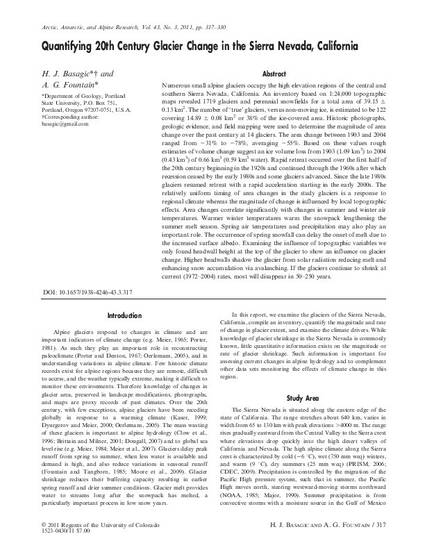
- Glaciers -- Sierra Nevada (Calif. and Nev.)-- Environmental aspects,
- Glaciers -- Sierra Nevada (Calif. and Nev.)-- Climatic factors
- Geology and
- Glaciology
Numerous small alpine glaciers occupy the high elevation regions of the central and southern Sierra Nevada, California. An inventory based on 1:24,000 topographic maps revealed 1719 glaciers and perennial snowfields for a total area of 39.15 +/- 0.13 km(2). The number of 'true' glaciers, versus non-moving ice, is estimated to be 122 covering 14.89 +/- 0.08 km(2) or 38% of the ice-covered area. Historic photographs, geologic evidence, and field mapping were used to determine the magnitude of area change over the past century at 14 glaciers. The area change between 1903 and 2004 ranged from -31% to -78%, averaging -55%. Based on these values rough estimates of volume change suggest an ice volume loss from 1903 (1.09 km(3)) to 2004 (0.43 km(3)) of 0.66 km(3) (0.59 km(3) water). Rapid retreat occurred over the first half of the 20th century beginning in the 1920s and continued through the 1960s after which recession ceased by the early 1980s and some glaciers advanced. Since the late 1980s glaciers resumed retreat with a rapid acceleration starting in the early 2000s. The relatively uniform timing of area changes in the study glaciers is a response to regional climate whereas the magnitude of change is influenced by local topographic effects. Area changes correlate significantly with changes in summer and winter air temperatures. Warmer winter temperatures warm the snowpack lengthening the summer melt season. Spring air temperatures and precipitation may also play an important role. The occurrence of spring snowfall can delay the onset of melt due to the increased surface albedo. Examining the influence of topographic variables we only found headwall height at the top of the glacier to show an influence on glacier change. Higher headwalls shadow the glacier from solar radiation reducing melt and enhancing snow accumulation via avalanching. If the glaciers continue to shrink at current (1972-2004) rates, most will disappear in 50-250 years.

Originally published in Arctic, Antarctic, and Alpine Research (http://instaar.colorado.edu/AAAR/index.php)